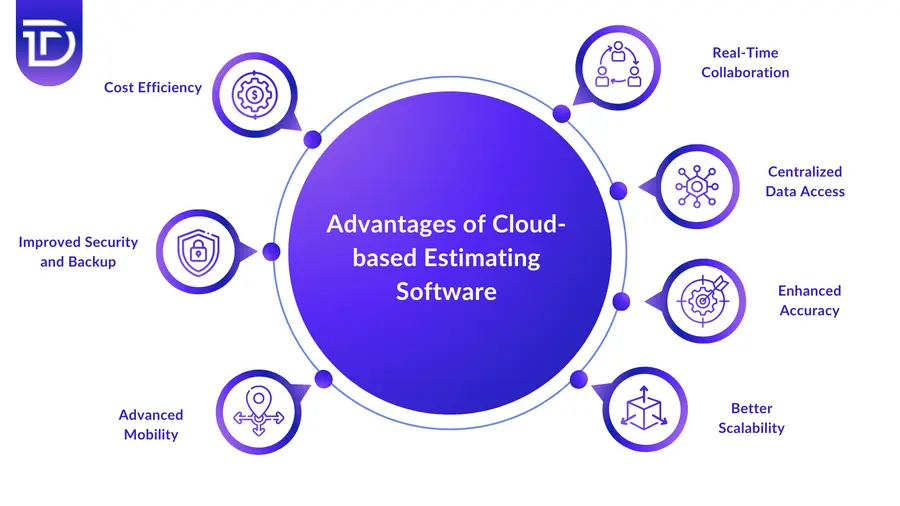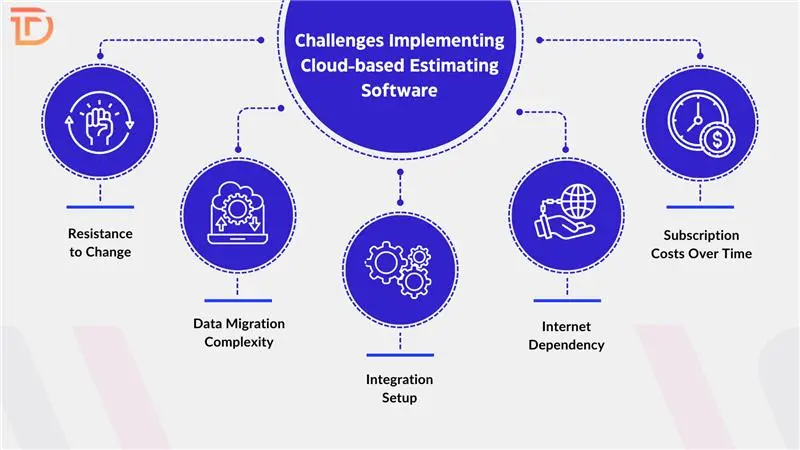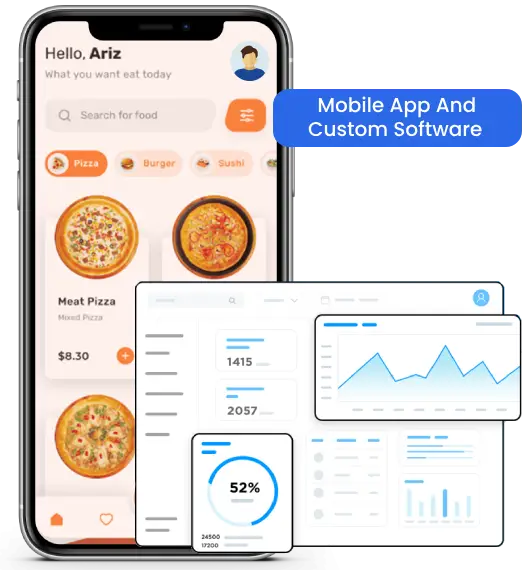Estimating project costs often proves to be a complex and time-consuming task with high stakes. Cloud estimating software simplifies this process by putting calculations, designs, and pricing data in one accessible digital location. Teams no longer rely on scattered spreadsheets or email chains to align their work. Remote contributors can work together in real time, reducing errors and delays. Modern businesses gain a competitive edge when estimating becomes fast, accurate, and collaborative. Shared visibility and consistent updates help teams deliver bids that are more precise and timely. Success often starts when collaboration tools replace friction with smooth workflows. In this blog, we will explore what cloud-based estimating tools are, highlight their key advantages, explain how they enhance team collaboration, and uncover the industries that benefit most from their implementation.
What Are Cloud-based Estimating Tools?
Cloud-based estimating tools consist of online platforms that allow teams to create, share, and manage project estimates from anywhere with internet access. These tools centralize cost data, pricing libraries, templates, and historical records in one secure environment. Team members collaborate across departments and locations on estimates without version conflicts. The platform updates content instantly so everyone sees the most current information. Integrations with accounting, CRM systems, and project management software keep estimates connected to wider workflows. User interfaces often include configurable templates, drag-and-drop assemblies, and mobile-friendly dashboards. Tools adapt to work environments whether in the office, at client sites, or on remote devices.
Advantages of Cloud-based Estimating Software
Cloud-based estimating software offers several game-changing benefits that directly improve efficiency, accuracy, and collaboration across projects. Businesses looking to streamline estimating processes will find the following advantages particularly impactful:

Real-Time Collaboration
Remote estimators, project managers, and stakeholders can edit a single version of an estimate simultaneously. Instant updates reduce email chains and miscommunication. Visibility elevates throughout teams, minimizing duplication and version control errors. Every team member stays on the same page, regardless of their physical location. This real-time visibility fosters accountability, improves coordination between departments, and enables faster decision-making during tight deadlines or urgent project changes.
Centralized Data Access
All cost items, pricing tables, and reference materials live in one central repository. Team members access the same up-to-date files. No more manual syncing or outdated information. Centralization eliminates the risk of working from the wrong document version. It streamlines the estimating process by ensuring uniformity in data inputs, helping teams produce more consistent and accurate estimates that align with the latest company standards and requirements.
Enhanced Accuracy
Automated calculations and integrated error checks reduce mistakes that arise from manual data entry. Alerts for inconsistent unit rates or atypical totals help catch errors early. Intelligent systems flag discrepancies that might otherwise go unnoticed, saving teams from costly miscalculations. With historical data at their fingertips, estimators can benchmark against previous projects to validate new bids, enhancing both precision and confidence in their numbers.
Better Scalability
Cloud services grow with project demands. Adding users, projects, or storage happens without costly hardware purchases. Platforms adapt to small contractors and large firms alike without overhauling infrastructure. As business needs change, the software can be scaled up or down instantly. Teams can onboard new estimators or partners effortlessly, making it easier to expand into new markets or manage a growing portfolio of projects.
Advanced Mobility
Access estimates from desktop, laptop, tablet, or mobile devices. Teams in the field, at client offices, or traveling remain fully functional. Updates appear instantly across all devices. This mobility empowers field staff to contribute valuable real-time input, such as site conditions or customer feedback, directly into the estimate. As a result, teams respond faster to new requirements, project changes, or client queries, improving agility and responsiveness.
Improved Security and Backup
Cloud providers offer encrypted storage, regular backups, and disaster recovery systems. Sensitive project data stays safe against hardware failures, theft, or accidents. Enterprise-grade security protocols protect estimates from unauthorized access or tampering. Role-based access ensures the right people have the right permissions. With automatic backups and recovery tools, businesses can restore data quickly in case of disruption, ensuring minimal downtime and peace of mind.
Cost Efficiency
Subscription pricing reduces upfront costs associated with desktop software. Updates occur automatically and maintenance shifts to the provider. Lower IT overhead frees resources for other priorities. Budget forecasting becomes easier, as subscription models offer predictable monthly or annual fees. Teams also save on training, licensing, and internal IT support, which means more funds can be allocated to innovation, client services, or expanding business operations.
Features to Look for in Cloud-based Estimating Tools
Modern estimating tools offer more than just digital spreadsheets. The right features make collaboration seamless, reduce errors, and ensure consistency across projects. Choosing the best solution requires attention to key features. The essential capabilities of cloud-based contractor estimating software include:
Template Customization
Ability to design or modify estimation templates and assemblies that suit specific project types. Custom templates save time and enforce consistency across repeated bids. Teams can also pre-load materials, labor, and cost structures, reducing repetitive manual entry and minimizing human error. This standardization ensures that even large teams maintain accuracy and efficiency across multiple projects.
Real-Time Notifications and Workflow Alerts
Built-in notifications for estimate changes, approvals, or reviews help teams stay aligned. Workflow alerts reduce missed feedback and support timely decision-making. Notifications can be tailored by user roles, ensuring the right individuals are informed at the right time. Prompt alerts help avoid bottlenecks, reduce delays, and maintain continuous progress throughout the estimating cycle.
Integration Capabilities
Seamless connection to accounting tools, CRM systems, scheduling applications, or procurement platforms ensures data flows smoothly between stages of project delivery. These integrations remove the need for manual data transfer, preventing duplication and ensuring accuracy. Connected systems also provide a holistic view of project performance and financial health in real time.
Detailed Reporting and Analytics
Platform should offer visuals such as cost breakdown charts, project histories, variance reports, and profitability insights. Detailed analytics helps teams refine estimates and performance regularly. Custom reporting allows managers to filter data by project, region, or phase, enabling deeper insights that guide better forecasting, budgeting, and strategic decisions over time.
Mobile-Friendly Interface
Estimating should be efficient on-the-go. A user interface that works well on tablets or smartphones provides convenience and flexibility to team members working remotely or on site. Mobile access empowers teams to update estimates in real time, reference project data during client meetings, and make quick edits from anywhere, improving responsiveness and productivity.
Challenges in Implementing Cloud-based Estimating Software
Adopting advanced tools offers powerful advantages, but the transition is rarely seamless. Successful implementation requires overcoming several operational, technical, and cultural obstacles along the way. The common hurdles in implementing cloud based estimating software include:

Resistance to Change
Teams accustomed to spreadsheets may resist moving to a cloud environment. Training and cultural shifts become necessary to gain adoption. Long-standing workflows are often deeply embedded, making users hesitant to trust new systems. Overcoming this requires consistent communication, hands-on training sessions, and highlighting the long-term benefits of increased accuracy and productivity.
Data Migration Complexity
Moving legacy data into new systems requires time and effort. Ensuring accuracy and structure during migration demands careful planning and validation. Existing spreadsheets may be unstructured or inconsistent, requiring cleanup before import. Teams must also verify that critical information is preserved and matches the format of the new platform to avoid future issues.
Integration Setup
Initial connection to accounting, scheduling, or CRM platforms may encounter technical hurdles. Configuring secure data flows often requires IT support. Compatibility between systems isn’t always guaranteed, which can delay implementation timelines. Ongoing maintenance is also needed to keep integrations functional as updates roll out across different platforms or APIs.
Internet Dependency
Cloud tools require reliable internet access. Field locations with poor connectivity may hamper access to real-time data and collaboration features. Project teams may struggle to sync updates or retrieve estimates quickly during site visits. Investing in offline capabilities or mobile hotspots can help bridge the gap in low-coverage areas.
Subscription Costs Over Time
Subscription-based pricing can accumulate. Teams must evaluate return on investment and forecast long-term value to ensure cost-effectiveness. Without regular usage and strategic planning, businesses may pay for features that go underutilized. Clear usage tracking and cost-benefit analysis are necessary to maximize the value of the ongoing expense.
Enhancing Team Collaboration with Cloud-Based Estimating Tools
Cloud-based estimating tools bring people together in more ways than just shared screens. Remote teams participate in live editing, seeing changes from peers as they happen. Feedback loops shorten. Everyone speaks a shared data language, reducing miscommunication.
Updates to pricing, labor rates, or project scope appear immediately to all, cutting down on review cycles. Shared dashboards allow managers to assign tasks, track progress, and enforce timeline awareness.
Conversations shift from file confusion to action. Estimators, designers, project leads, and procurement teams align better when working within the same estimating environment. Transparency brings accountability, as audit trails record who made changes when.
Collaborative estimates help reduce bottlenecks in approvals. Stakeholders review estimates and approve or comment directly within the tool. Approval timelines shrink and bidding speeds improve. Solutions that function as construction collaboration software further enhance this workflow, making it easier for distributed teams to work in sync without sacrificing accuracy or speed.
Cross-disciplinary feedback happens sooner. Estimators pick up procurement notes, scheduling flags, or designer constraints instantly. That early alignment keeps projects consistent and prevents major rework later.
Real-time updates from job sites or client visits feed right into the estimate. Changes flow directly into the live document, so estimators stay current. Integration between field and office minimizes communication gaps that previously stalled collaboration. Tools like a construction cost calculator further streamline these updates by providing accurate pricing data instantly, helping teams respond faster to change.
Which Industries Can Benefit from Cloud-based Estimating Software?
Modern estimating software is no longer limited to one sector. Many industries now rely on cloud platforms to streamline workflows, improve accuracy, and enhance collaboration. Below are industries that benefit significantly from cloud-based estimating software:
Manufacturing and Engineering
Teams across departments such as procurement, design, and cost control converge on estimates in real time. Engineering changes and cost impacts get addressed quickly, keeping production and design timelines aligned. Estimating tools help calculate costs for components, raw materials, and assembly processes with precision. Integration with CAD and ERP systems improves overall project alignment, enabling quicker decision-making and better cost forecasting throughout the product development cycle.
Construction and Contracting
Estimators, project managers, and subcontractors benefit from unified cloud construction software. Estimates remain consistent whether in the field or headquarters. Faster bids and accurate data improve profitability and competitiveness. The ability to track labor, material costs, and scope changes in real time minimizes delays and helps avoid over-budget surprises. Teams work with synchronized information, which leads to more transparent client communication and better project planning. When integrated with construction management software, these remodeling estimating software for builders offer a complete solution that connects budgeting with scheduling, reporting, and on-site execution.
Professional Services
Consultants and service firms often price project phases, resources, or deliverables. Cloud estimating helps teams coordinate estimates across locations, teams, or client sites, making proposals more accurate and collaborative. Real-time collaboration enables faster revisions, while built-in templates support standardized pricing for recurring service packages. This leads to stronger client trust, reduced back-and-forth, and improved project delivery timelines across multiple stakeholders.
Final Words
Cloud-based estimating tools fundamentally improve how teams work together. Shared access, real-time updates, integrations, and mobile convenience elevate productivity and precision. Teams communicate more smoothly without confusion over outdated files. Collaboration increases as stakeholders participate directly within the estimating environment. Projects benefit from shared vision and better alignment.
Ready to improve your estimating workflows with cloud-powered collaboration and accuracy? Dreamer Technoland specializes in the implementation of cloud-based estimating software customized for your workflow and industry. Our expert in-house developers and consultants help you migrate data, configure integrations, and train teams so every step aligns with collaborative success.







